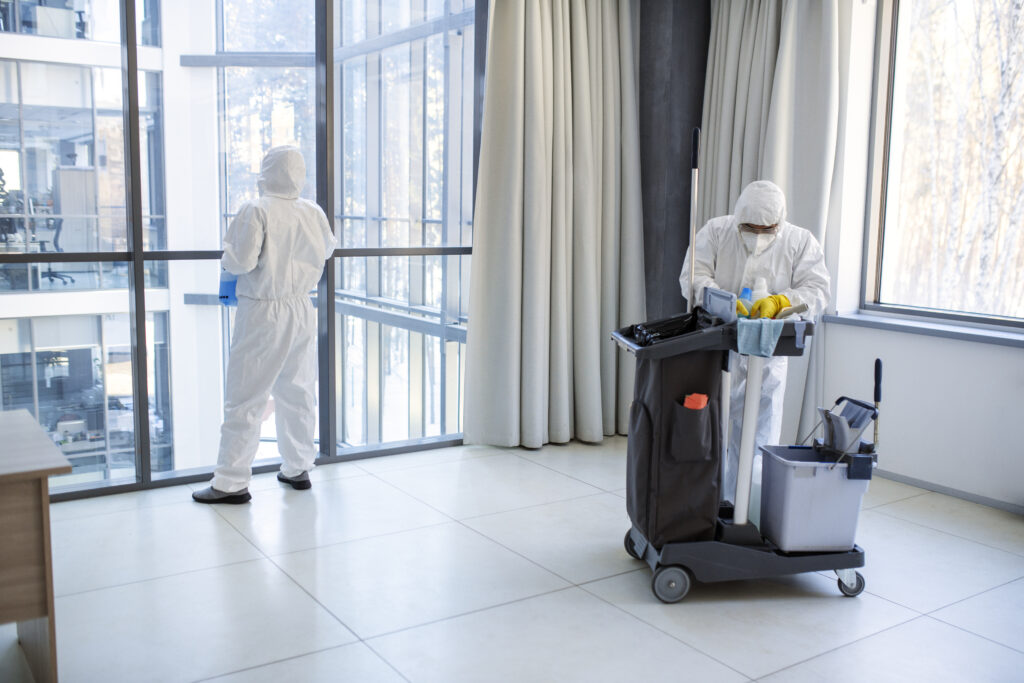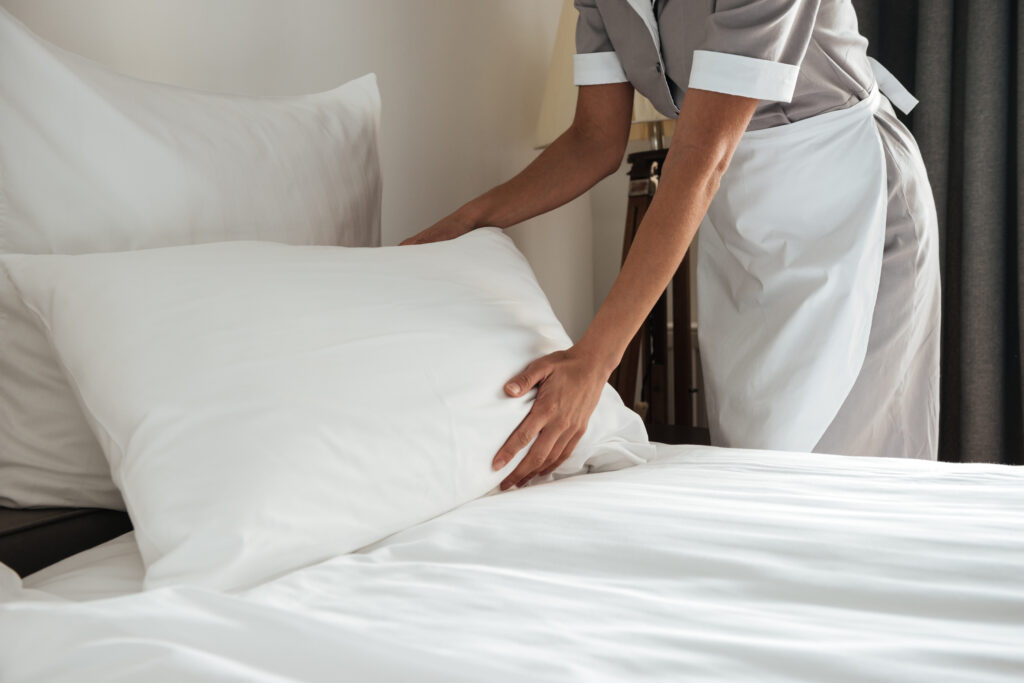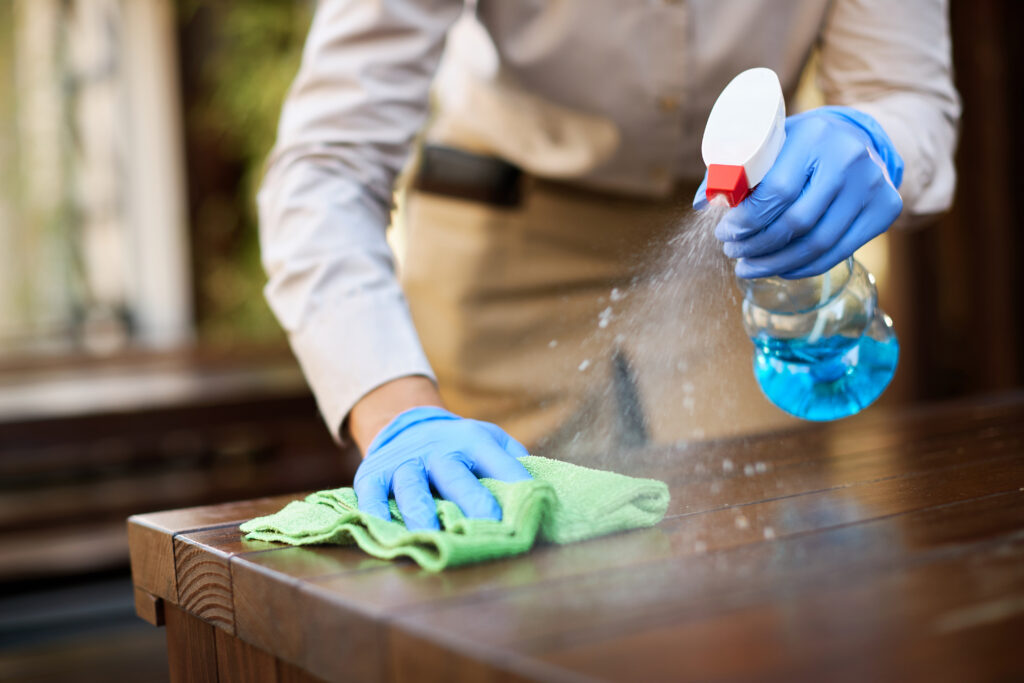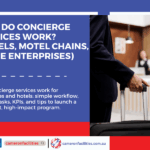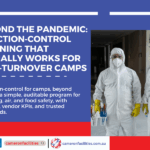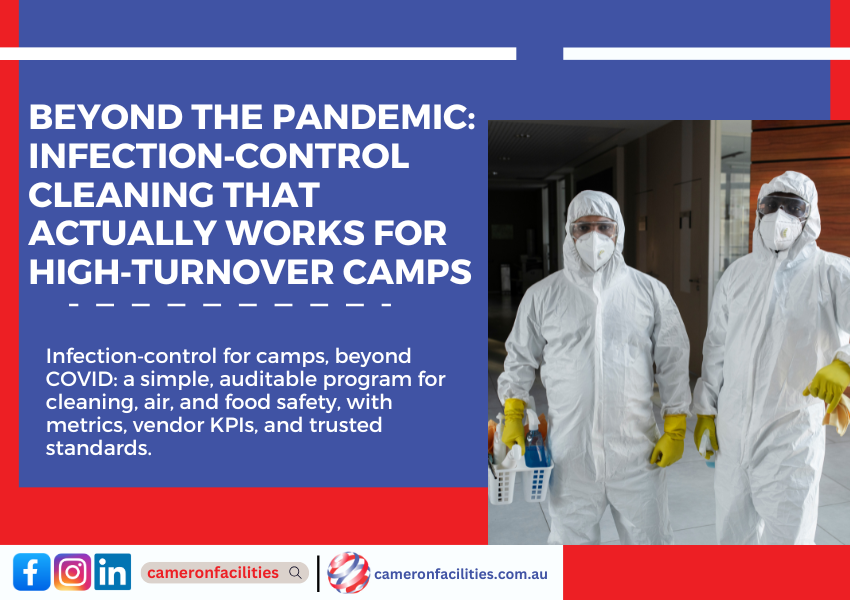
Thought leadership for corporate facility, operations, and HSE leaders
High‑turnover camps don’t catch a break. One case of illness can sideline a crew and disrupt a whole shift.
The pandemic pushed us to clean more. But the real risk today is broader: norovirus in shared dining, flu moving through bunkhouses, RSV, and colds in crowded transport. The solution is not “more bleach.” It’s a clear, standards‑driven program you can audit, improve, and show to stakeholders.
“We stopped talking about COVID, but bugs didn’t stop moving through shared kitchens and bunkhouses.”
This post lays out a practical playbook you can deploy across camps—simple enough for the front line, strong enough for board‑level risk reporting.
The risk hasn’t vanished; only the headlines have
Shared rooms, shared bathrooms, shared dining. These are perfect settings for germs to spread.
- Norovirus is a classic camp disruptor. It spreads fast and survives on surfaces. The CDC notes it causes millions of gastroenteritis cases each year and can shut down group settings quickly. Read more here: norovirus prevention and cleaning.
- Respiratory viruses like flu and RSV move in indoor air and on shared touchpoints. Good ventilation and smart cleaning cut risk.
Bottom line: if turnover is high, risk is constant. The task is to control it with repeatable steps.
The Big Three: cleaning, air, and food safety
Think of infection control as a three‑legged stool. If one leg is weak, the whole program wobbles.
1) Environmental cleaning (and verification)
Cleaning must match the way people use a space, not just a daily schedule.
- Target high‑touch points: handles, switches, rails, remotes, fridge doors, and shared equipment.
- Use the right product for the job: follow the label for contact time and soil type.
- Shift to “outbreak mode” fast: double down on shared bathrooms, dining areas, and crew transport when cases spike.
- Verify the work: simple procedural audits and ATP checks (where appropriate) keep standards real.
Practical, step‑by‑step guidance is available from Australia’s national program on infection prevention and control. See: environmental cleaning resources from the Australian Commission on Safety and Quality in Health Care.
“If it isn’t documented, it didn’t happen.” That’s the rule to run by. Your supervisors need proof they can trust.
2) Ventilation and indoor air quality (IAQ)
Air is part of cleaning. Fresh outdoor air lowers the chance that a virus cloud builds up in a room.
- Bring in more outdoor air and keep systems well‑maintained.
- Use filtration that matches your HVAC and the risk of the space. Portable HEPA units can help in crowded rooms.
- Use CO₂ as a simple proxy for freshness when appropriate. It’s not a pathogen meter, but it helps you spot rooms that need more air.
To align with Australian guidance, start with the latest take on mechanical ventilation (AS 1668.2). A plain‑English starting point is the Standards Australia note here: AS 1668.2:2024 mechanical ventilation, and this government overview on indoor air quality for practical steps.
3) Food safety in camp kitchens (new rules apply)
Food is a major vector in camps. Since December 2023, Australia has required extra tools in many food businesses under Standard 3.2.2A.
What it means for camps:
- Food handler training is now mandatory for relevant roles.
- A qualified Food Safety Supervisor must be on hand when required.
- Prove your controls for higher‑risk tasks (like preparing ready‑to‑eat foods).
Start here: the Food Standards Australia New Zealand explainer on Food Safety Management Tools – Standard 3.2.2A. State guidance adds detail for implementation (for example, see NSW Food Authority 3.2.2A guidance).
“Our kitchen runs smoother with 3.2.2A. Training is clear, responsibilities are clear, and audits are calmer.”
Turn cleaning into an auditable system, not a chore list
The biggest shift is in mindset. We’re not buying more wipes. We’re building a system.
Build a simple SOP stack:
- Policy: one page that states your infection‑control intent and scope across cleaning, air, food, laundry, and waste.
- SOPs: short, step‑by‑step procedures for each space and task. Include product, dwell time, PPE, and frequency.
- Checklists: daily and weekly. Make them easy to tick on mobile.
- Training & refreshers: short toolbox talks beat long manuals.
- Evidence: photos, logs, and QA spot checks.
Get third‑party proof to show clients, workers, and regulators you mean it:
- The GBAC STAR Facility Accreditation program turns cleaning, disinfection, and infectious‑disease prevention into a quality system. Learn more: GBAC STAR program.
- The WELL Health‑Safety Rating validates policies for cleaning, maintenance, IAQ, and emergency plans, and comes with a recognizable seal. Explore: WELL Health‑Safety.
These signals map neatly to ESG disclosures and contractor pre‑qualification.
Don’t forget linen and waste streams
High‑turnover camps live and die by laundry. Poor flow can spread contamination and complaints.
- Separate dirty and clean zones. Use a one‑way workflow.
- Follow time‑temperature controls matched to fabric and infection risk.
- Bag and handle soiled items safely to avoid aerosolizing contaminants.
For technical detail, see the industry update replacing AS/NZS 4146:2000: the forthcoming Laundry Practice revision. Your supplier or standards provider can guide access and implementation (starting point: Standards Australia search for laundry practice standard).
Waste also matters. Work with local public health on disposal rules. In some settings, wastewater surveillance offers early warning for outbreaks in remote camps. A good overview is CSIRO’s page on wastewater‑based epidemiology, with state programs like NSW Health wastewater insights showing how to plan sampling.
“Camps turn over linen daily. Getting the laundry flow right is as important as wiping a bench.”
Metrics leaders care about
Executives want fewer surprises and stronger proof. Track a small set of numbers that link to risk and uptime.
Leading indicators (show if controls are in place):
- % of scheduled cleaning tasks verified on time
- Hours per week rooms stay within target IAQ parameters
- % of staff with current food‑safety training and supervisor coverage
- Laundry QA pass rate (load temps/time, segregation checks)
Lagging indicators (show outcomes):
- Days since last confirmed outbreak
- Time to activate “outbreak mode” SOP after a trigger
- % of service complaints tied to hygiene
Publish these in an operations dashboard and discuss them in toolbox talks. Tie them to bonuses and vendor KPIs.
Buying and contracting smarter
Your vendor should be a system partner, not just a labour line.
Ask for this in tenders and reviews:
- Alignment to GBAC STAR or WELL Health‑Safety and proof of current status
- Clear plan for Standard 3.2.2A compliance in kitchens
- IAQ service levels (outdoor air, filtration, maintenance cadence)
- Outbreak surge plan (people, equipment, extra cleans) within 4–8 hours
- Training matrix, with refreshers and sign‑offs
- Data reporting: weekly verification, monthly metrics, and incident logs
- Evidence of chemical stewardship (SDS set, compatibility, dilution control)
Model KPIs:
- ≥ 95% on‑time task verification each week
- ≤ 24 hours to complete corrective actions from audits
- 100% training compliance for food handlers and supervisors
- IAQ parameters in range ≥ 90% of occupied hours
“Don’t buy hours. Buy outcomes you can see and verify.”
A simple 30/60/90‑day roadmap
Day 0–30: Stabilise
- Publish the infection‑control policy and appoint owners.
- Update SOPs and checklists for the top five risk spaces.
- Set up weekly verification and a simple dashboard.
- Train supervisors on outbreak mode.
Day 31–60: Strengthen
- Map HVAC and add quick wins: filter checks, outside air tweaks, CO₂ spot checks.
- Close gaps for 3.2.2A in kitchens (training, supervisor, records).
- Fix laundry flow and temperature controls.
Day 61–90: Signal
- Choose GBAC STAR and/or WELL Health‑Safety and start the documentation pack.
- Lock in vendor KPIs and reporting cadence.
- Brief the board on the new dashboard.
Key Takeaways
Cleaning for high‑turnover camps is not about doing “more.” It is about doing the right things, the same way, every time, and proving it.
Build your program on the Big Three (cleaning, air, and food safety), add strong laundry and waste practices, and back it with third‑party validation. You’ll cut illness, protect rosters, and give leaders the proof they need.
Explore these starting points:
- GBAC STAR program
- WELL Health‑Safety
- Environmental cleaning resources
- Food Safety Management Tools – Standard 3.2.2A
Need reliable and trustworthy housekeeping and cleaning services? Cameron Facilities provides state-of-the-art cleaning services for commercial, industrial, and residential establishments. Contact us today to know more.
